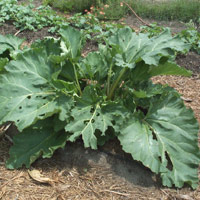Rhubarb

Although technically a vegetable, rhubarb is generally used as a fruit in desserts and jams. Attractive and easy to grow, rhubarb has a place in every home garden.
About This Plant
Rhubarb is a perennial vegetable; put it where it won't be disturbed. Purchase and plant rhubarb roots (not seeds) in early spring as soon as the soil can be worked. Three to five plants should provide enough for an average family.
Site Selection
Select a well-drained site in full sun. Eliminate all perennial weeds before planting.
Care
Mulch with compost to provide nutrients and retain moisture during the summer. Remove seed stalks as they form. Dig and split roots every 3 to 4 years. Expand your patch or give root sections away. If you keep your rhubarb patch weed-free, it is not apt to be disturbed by insects or diseases.
Planting Instructions
Dig large bushel basket-size planting holes and add a mixture of equal parts garden soil, sand, and rotted manure or compost. Space rhubarb roots 4 feet apart. Set roots so buds are 1 to 2 inches below the surface of the soil, cover with soil, and firm the area.
Harvesting
Let your rhubarb grow without harvesting any stalks the first year so the plants can become established. If the plants show vigorous growth during the second season, you can harvest a light crop. By the third year, you can take most of the stalks. To harveset, simply pull gently on the stalks to dislodge them from the plant. You can pull all of the stalks at one time or pulled them out as you need them over a four to six week period. Remove and compost the leaves, as they contain high levels of oxalic acid, which is toxic in high doses.






 Although technically a vegetable, rhubarb is generally used as a fruit in desserts and jams. Attractive and easy to grow, rhubarb has a place in every home garden.
Although technically a vegetable, rhubarb is generally used as a fruit in desserts and jams. Attractive and easy to grow, rhubarb has a place in every home garden.